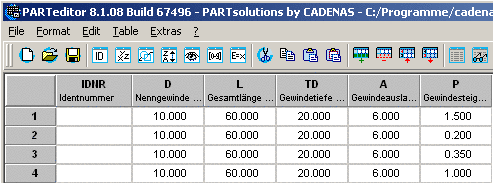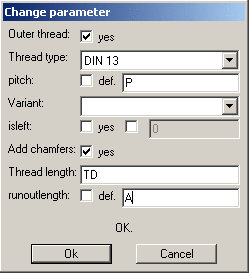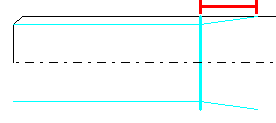Manual
Login
Our 3D CAD supplier models have been moved to 3Dfindit.com, the new visual search engine for 3D CAD, CAE & BIM models.
You can log in there with your existing account of this site.
The content remains free of charge.

Top Links
Manual
Based on the following example, which you can find under "$CADENAS/training/partdesigner/gewinde3.prj", you can understand the use of the thread features.
A simple pin can be used as an example:
-
Apply the following variables:
![[Note]](/community/externals/manuals/%24%7Bb2b:MANUALPATH/images/note.png)
Note The values used for the thread pitch and the nominal thread diameter must also be available in the thread table under "$CADENAS_DATA\datasetup\threads"!
-
Pull a rectangle onto the variables D and L.
-
![[Note]](/community/externals/manuals/%24%7Bb2b:MANUALPATH/images/note.png)
Note The buttons Cylindrical thread by length and Conical thread by lengths are only then active, once a Rotation axis has been defined!
-
Follow the information in the footnote:
Click on the following sketch elements and areas.
-
TheChange parameter window opens.
-
Adjust your entries in the Change parameter window. Set the applied variables.
-
Per default, DIN13 is set. If desired, change with the selection list.
-
Per default, the checkbox "def." is set. A pitch thread according to the set standards is created.
If you want to create a fine thread with defined thread pitches, deactivate the checkbox and enter the variable name for the thread pitch ('P').
![[Note]](/community/externals/manuals/%24%7Bb2b:MANUALPATH/images/note.png)
Note For a fine thread the variable 'P' must be applied for the thread pitch in the table!
See also Section 7.5.4.3.11.1.1.2, “Fine thread - variants ”.
-
Only used for certain thread, such as DIN1, and enables further specification.
-
If you activate the second checkbox, you can carry out the query of whether left or right thread via the table as well. In this case, enter the respective variable name into the input field.
-
-
-
All entries are immediately displayed in the sketch.
The thread is automatically specified as a cosmetic element (blue lines).
In order to calculate the variants, variable 'P' = Thread pitch is required. Row Label and Core diameter, for example, are calculated from 'P'.
Via the following expression you can create different output texts with adjustments.
NAME = GETTHREADTEXT(D,'DIN 13','',P,'NAME')
Different options can be taken from the two following tables:
Output text
NAME = GETTHREADTEXT(D,'DIN 13','',P,'NAME') // results in, for example, M10x1
TYPE = GETTHREADTEXT(D,'DIN 13','',P,'TYPE') // results in, for example, M
KDI = GETTHREADTEXT(D,'DIN 13','',P,'KDI') // core diameter inner thread
KDA = GETTHREADTEXT(D,'DIN 13','',P,'KDA') // core diameter outer thread
SIZE = GETTHREADTEXT(D,'DIN 13','',P,'SIZE') // results in, for example, 10x1
| D | DIN 13 | Empty | 'P' | Description |
| Nominal thread diameter | Standard name | Currently not in use |
Via the variable 'P', the Thread pitch is read from the table. |
Modifies the output text |
Apply the respective Attribute algorithms.
The variable 'GEW' in this example can be used under PARTproject -> General1 -> Row Label.
GEW = GETTHREADTEXT(D,'DIN 13','',P,'NAME')
KDA = GETTHREADTEXT(D,'DIN 13','',P,'KDA')
The following images show the displays in the PARTdataManager with different thread pitches and the 2-D derivation.
















